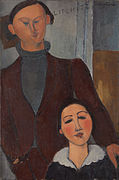
School of Paris
The School of Paris (French: École de Paris) refers to the French and émigré artists who worked in Paris in the first half of the 20th century.
This article is about the 20th century School of Paris. For the medieval manuscript illuminators, see School of Paris (Middle Ages).Location
France, Israel, US
The School of Paris was not a single art movement or institution, but refers to the importance of Paris as a center of Western art in the early decades of the 20th century. Between 1900 and 1940 the city drew artists from all over the world and became a centre for artistic activity. School of Paris coined by André Warnod, was used to describe this loose community, particularly of non-French artists, centered in the cafes, salons and shared workspaces and galleries of Montparnasse.[1] Many artists of Jewish origin formed a prominent part of the School of Paris and later heavily influenced art in Israel.
Before World War I the name was also applied to artists involved in the many collaborations and overlapping new art movements, between post-Impressionists and pointillism and Orphism, Fauvism and Cubism. In that period the artistic ferment took place in Montmartre and the well-established art scene there. But Picasso moved away, the war scattered almost everyone, by the 1920s Montparnasse had become a center of the avant-garde. After World War II the name was applied to another different group of abstract artists.
Jewish School of Paris[edit]
France[edit]
Artists of Jewish origin had a marked influence in the École de Paris. Paris the capital of the art world attracted Jewish artists from Eastern Europe, several of them fleeing persecution, discrimination and pogroms. Many of these artists settled in Montparnasse.[17] Several Jewish painters were notable in the movement; these include Marc Chagall and Jules Pascin, the expressionists Chaïm Soutine and Isaac Frenkel Frenel as well as Amedeo Modigliani and Abraham Mintchine.[18][19][20] Many Jewish artists were known for depicting Jewish themes in their work, and some artists' paintings were imbued with heavy emotional tones. Frenkel described the artists as "members of the minority characterized by restlessness whose expressionism is therefore extreme in its emotionalism".[21]
The term l'École de Paris coined by the art critic André Warnod in 1925 in the magazine Comœdia, was intended by Warnod to negate xenophobic attitudes towards the foreign artists, many of whom were Jewish Eastern European.[22] Louis Vauxcelles wrote several monographs for the publisher Le Triangle, a prolific critic of Jewish painters. In a 1931 monograph, he wrote: "like a swarm of locusts, an invasion of Jewish colorists fell on Paris – on the Paris of Montparnasse. The causes of this exodus: the Russian revolution, and all that it brought with it of misery, pogroms, exactions, persecutions; the unfortunate young artists take refuge here, attracted by the influence of contemporary French art .... They will constitute [an element of] what the young critic will call the School of Paris. Many talents are to be considered in this crowd of metèques."[22]
Following the Nazi occupation of France; several prominent Jewish artists died during the holocaust,[23] leading to the dwindling of the Jewish School Of Paris. Others managed to left or fled Europe, mostly to Israel or the US.[18][17]
Musicians[edit]
In the same period, the School of Paris name was also extended to an informal association of classical composers, émigrés from Central and Eastern Europe to who met at the Café Du Dôme in Montparnasse. They included Alexandre Tansman, Alexander Tcherepnin, Bohuslav Martinů and Tibor Harsányi. Unlike Les Six, another group of Montparnasse musicians at this time, the musical school of Paris was a loosely-knit group that did not adhere to any particular stylistic orientation.[36]
Art Critics[edit]
Art critics and renowned writers have written prefaces, books, and articles regarding the painters of the School of Paris, notably in periodicals such as Libération, Le Figaro, Le Peintre, Combat, Les Lettres françaises, Les Nouvelles littéraires. Among these writers and critiques were Waldermar George, Georges-Emmanuel Clancier, Jean-Paul Crespelle, Arthur Conte, Robert Beauvais, Jean Lescure, Jean Cassou, Bernard Dorival, André Warnod, Jean-Pierre Pietri, George Besson, Georges Boudaille, Jean-Albert Cartier, Jean Chabanon, Raymond Cogniat, Guy Dornand, Jean Bouret, Raymond Charmet, Florent Fels, Georges Charensol, Frank Elgar, Roger Van Gindertael, Georges Limbour, Marcel Zahar.








